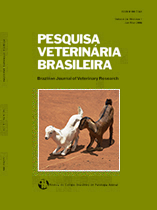 |
|
|
|
Year 2017 - Volume 37, Number 12
|

|
Histochemical and immunohistochemical evaluation of angiogenesis in rabbits (Oryctolagus cuniculus) submitted to skin grafts associated with platelet-rich plasma, 37(12):1519-1525
|
ABSTRACT.- Pazzini J.M., Serafim E.L., Gärtner F., Amorim I., Faria F., Rêma A., Moraes P.C. & De Nardi A.B. 2017. Histochemical and immunohistochemical evaluation of angiogenesis in rabbits (Oryctolagus cuniculus) submitted to skin grafts associated with platelet-rich plasma. Pesquisa Veterinária Brasileira 37(12):1519-1525. Departamento de Clínica e Cirurgia Veterinária, Faculdade de Ciências Agrárias e Veterinárias, Universidade Estadual Paulista, Campus Jaboticabal, Via de Acesso Paulo Donatto Castellane s/n, Jaboticabal, SP 14884-900, Brazil. E-mail: josipazzini@hotmail.com
Histochemical staining consists of a set of specific chemical reactions of structures or tissue-endogenous substances. Immunohistochemistry allows verification of proteins in tissues related to biological and pathological factors. The standardization of methods to assess angiogenesis resulting from formation of new blood vessels in procedures with stimulants is important to facilitate the implementation of research as well as to assist interpretation of data. In rabbits some markers of angiogenesis antibodies in the skin are not standardized because of cross-reactions that may occur because the antibodies are made from such animals.The aim of this study was to analyze the immunohistochemical methods through dyes and immunohistochemical markers angiogenesis in rabbits (Oryctolagus cuniculus) having undergone reconstructive surgery with skin grafts associated with plasma angiogenesis stimulator rich in platelets, in order to evaluate which method would be better to visualize the vessels, as well as to evaluate which antibody would promote better immunostaining, and find the differences between the methods and to standardize the methodology to be applied in experiments using rabbits. Sixteen rabbits were used, split into two groups of eight animals: Gprp (plasma rich in platelets) and Gc (control, saline solution, 9%). The same technique of reconstructive surgery using graft mesh was performed on each rabbit. The groups differed only in the application of platelet-rich plasma before the surgical wound synthesis. Samples for evaluation of angiogenesis were collected 15 days after the surgical procedure. The dyes Hematoxylin & Eosin and Masson’s Trichrome were used in the histochemical study to evaluate vascular proliferation. Markers CD31, CD34 and Caveolin-1 was used for the immunohistochemical study. The evaluation between the groups (Gprp and Gc) in regard to the categorical variable (vascular proliferation intensity) used the Kruskal-Wallis test with p values equal to or less than 0.05 being considered significant. The immunohistochemistry was subjected to analysis of variance for a completely randomized design, with two groups and five repetitions (medium) and 5% significance level. Multiple comparison of groups resulted in the Tukey test (p=0.05) used. The amount of vascular proliferation assessed by histochemical method HE and Masson’s Trichrome was found to be a significant variable in Gprp when compared with group Gc. When evaluating the methods used, there was no significant difference. There was no difference in the three markers which were used for correlating microvessels; however, there was more intense staining of vessels when Caveolin-1 Antibody was used. This caused intense marking of the capillaries and small vessels, as well as of larger vessels. When using CD31 and CD34, the same was observed, but it was not as intense as with Caveolin-1; though some cases showed sincere and discreet marking. The results of this study demonstrated that the histochemical methods performed are effective for semi-quantitative assessment of angiogenesis. The immunohistochemical comparison of Caveolin-1, CD31, and CD34 as markers of angiogenesis in rabbits showed that both antibodies could immunostain the newly formed vessels; but the Caveolin-1 showed better immunostaining in small and medium-sized vessels, as well as a minor presence in the background. Although not specific markers for angiogenesis, they can be used as immunohistochemical markers of vascular endothelium in rabbits. |
| |
|
|
| |
|
 |